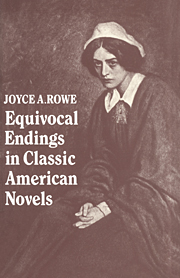 Equivocal Endings in Classic American Novels
Equivocal Endings in Classic American Novels Book contents
- Frontmatter
- Contents
- Acknowledgments
- Introduction
- 1 Nathaniel Hawthorne: “My Kinsman, Major Molineux”: The Several Voices of Independence
- 2 Bleak Dreams: Restriction and Aspiration in The Scarlet Letter
- 3 Mark Twain's Great Evasion: Adventures of Huckleberry Finn
- 4 Strether Unbound: The Selective Vision of Henry James's Ambassador
- 5 Closing the Circle: The Great Gatsby
- Conclusion: Moby-Dick and Our Problem with History
- Notes
- Index
5 - Closing the Circle: The Great Gatsby
Published online by Cambridge University Press: 17 August 2009
- Frontmatter
- Contents
- Acknowledgments
- Introduction
- 1 Nathaniel Hawthorne: “My Kinsman, Major Molineux”: The Several Voices of Independence
- 2 Bleak Dreams: Restriction and Aspiration in The Scarlet Letter
- 3 Mark Twain's Great Evasion: Adventures of Huckleberry Finn
- 4 Strether Unbound: The Selective Vision of Henry James's Ambassador
- 5 Closing the Circle: The Great Gatsby
- Conclusion: Moby-Dick and Our Problem with History
- Notes
- Index
Summary
I think that voice held him most, with its fluctuating warmth, because it couldn't be over-dreamed – that voice was a deathless song.
“Not in time is the race progressive,” Emerson proclaimed in 1839, and Fitzgerald's novel might be conceived as a latter-day meditation on that persistent American faith in the power of the individual to transcend his history, to create himself anew, for which Emerson's early essays serve as master text. For despite standard interpretations, The Great Gatsby seems to me no simple dramatization of either the moral futility of the American dream of success, nor the destruction of innocent aspiration in a fallen world; but, in fact, the most historically self-conscious consideration, among all these novels, of the contradictory nature of American idealism and the social cost of its attempt to subdue the facts of history to the faith of myth.
The ideal American of Emerson's radical essays is urged to transcend all temporal limitations now, to become his own redeemer through an immediate act of visionary possession that obliterates time by locating man in the eternal fullness of the present moment. Like the “blade of grass or the blowing rose,” man comes into his true inheritance by living “with nature in the present, above time.”
Emerson's conviction that the burden of time fractures consciousness and diminishes identity allows him to make his central denial of the power of history as a determinant in the shape of our lives. To the Emerson of the early essays, history has no delimiting force, for “being is without bounds.”
- Type
- Chapter
- Information
- Equivocal Endings in Classic American NovelsThe Scarlet Letter; Adventures of Huckleberry Finn; The Ambassadors; The Great Gatsby, pp. 100 - 126Publisher: Cambridge University PressPrint publication year: 1988


